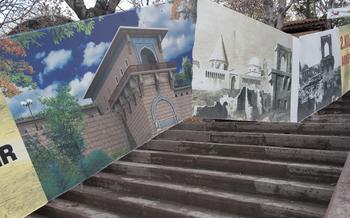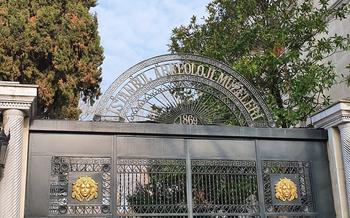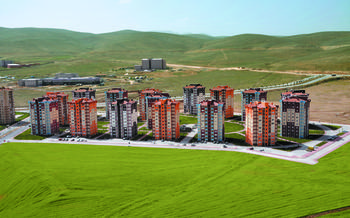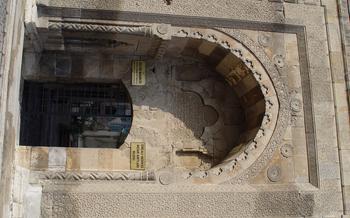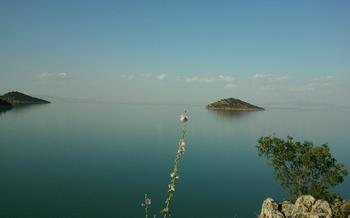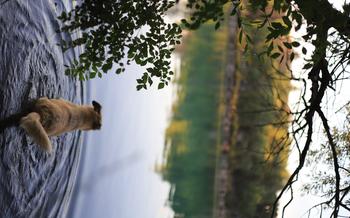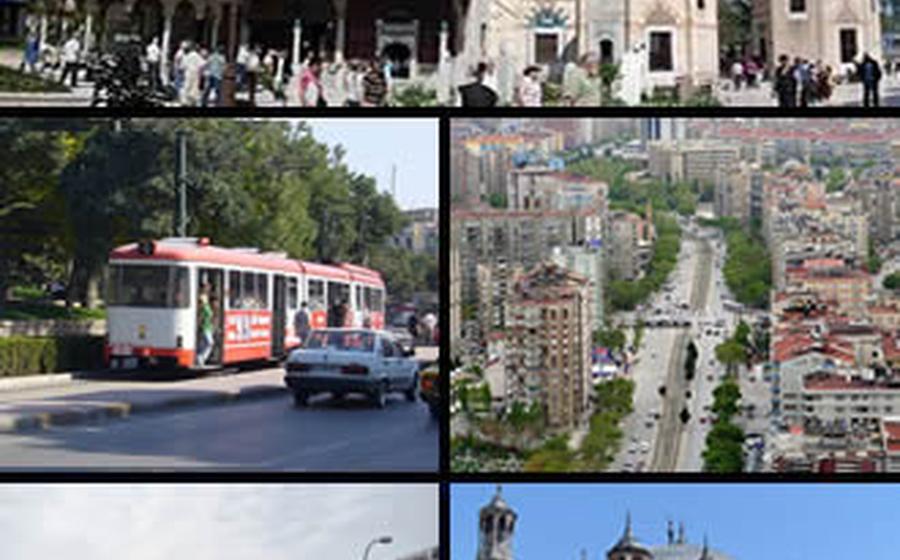
Kilistra Ancient City
- Exploring the Ancient History of Kilistra
- Getting There
- Entrance Fees and Hours
- Exploring the Ancient City
- The Temple of the Moon
- The City Walls: A Testament to Fortitude
- The Caravanserai
- The Museum
- The Surrounding Landscape:
- Local Cuisine: A Culinary Journey in Konya
- Souvenirs and Handicrafts
- Accommodation
- Additional Tips for Visitors
- Insider Tip: Exploring the Hidden Underground City
Exploring the Ancient History of Kilistra
Kilistra, situated in the heart of Turkey's Konya Province, holds a significant place in the annals of history. The city's ancient roots can be traced back to the Hittites, an influential civilization that ruled Anatolia during the Bronze Age. Excavations at the site have unearthed a wealth of architectural remains and artifacts, shedding light on the city's rich past.
Kilistra's strategic location along ancient trade routes made it a vital hub for cultural and commercial exchanges. The city's prosperity was reflected in its impressive fortifications, temples, and residential areas, showcasing the remarkable engineering and artistic skills of the Hittites.
One of the most intriguing aspects of Kilistra is the presence of hieroglyphic inscriptions, providing valuable insights into the ancient Anatolian languages. These inscriptions have helped scholars decipher the mysteries of the Hittite language and gain a deeper understanding of their culture and history.
As you explore Kilistra, you'll be transported back in time, experiencing the grandeur of a once-powerful civilization. The city's evocative ruins and artifacts offer a glimpse into the lives of the Hittites, their beliefs, and their contributions to the development of ancient Anatolia.
Getting There
Kilistra is situated approximately 130 kilometers southeast of Konya, at the foot of the Taurus Mountains. Reaching Kilistra from Konya is relatively straightforward, with several transportation options available. To experience the scenic beauty of the Turkish countryside, consider renting a car and driving along the well-maintained roads. The journey takes around two hours, allowing you to enjoy the rolling hills, fertile plains, and distant mountains along the way.
Alternatively, you can take a comfortable bus ride from Konya's bus terminal. Buses depart regularly throughout the day, and the journey takes approximately two and a half hours. Upon arrival at Cili, a small town near Kilistra, you can take a local taxi or minibus to reach the ancient city.
The ideal time to visit Kilistra is during the spring or autumn months (April-May and September-October) when the weather is pleasant and conducive to outdoor exploration. Summer months can be hot and dry, while winters can be cold and snowy, making it less ideal for sightseeing.
Entrance Fees and Hours
Visiting Kilistra is an affordable experience, with entrance fees set at a reasonable rate. There are no additional charges for guided tours or photography. However, it's always a good idea to carry some cash as there may be limited access to ATMs or card payment facilities in the area.
The site is open to the public daily, except for Mondays, from 8:30 AM to 5:00 PM. These hours may vary slightly during the off-season or on public holidays, so it's advisable to check the official website or contact the local tourism office for the most up-to-date information.
To fully appreciate the site's grandeur and avoid the midday heat, it's recommended to visit Kilistra early in the morning or late in the afternoon. The golden light of sunrise and sunset casts a magical glow on the ancient ruins, creating a picturesque backdrop for memorable photographs.
Exploring the Ancient City
Kilistra's layout reveals a fascinating tapestry of ancient urban planning. The city walls, which once stood as formidable barriers, now offer a glimpse into the defensive prowess of the Hittites. Inside the walls, visitors can wander through the remnants of temples, administrative buildings, and residential areas, each telling a story of the city's vibrant past.
One of the most intriguing features of Kilistra is the presence of hieroglyphic inscriptions scattered throughout the site. These inscriptions, written in the Luwian language, provide invaluable insights into the religious beliefs, mythology, and history of the Hittite civilization. Deciphering these inscriptions has been a labor of love for scholars, shedding light on the rich tapestry of ancient Anatolian languages and cultures.
Ongoing excavations and restoration projects add an element of dynamism to the site. Visitors may encounter archaeologists carefully unearthing new artifacts or witness the painstaking process of restoring ancient structures to their former glory. These projects offer a unique opportunity to witness firsthand the dedication and expertise involved in preserving our cultural heritage.
The Temple of the Moon
The Temple of the Moon, dedicated to the goddess Kubaba, stands as a testament to the religious beliefs and practices of the ancient Hittites. Its architectural design, characterized by intricate carvings and symbolic motifs, reflects the importance of this temple in Hittite society. The temple's interior, once adorned with colorful frescoes and statues, provided a sacred space for rituals and ceremonies honoring the moon goddess.
The Temple of the Moon played a crucial role in Hittite religious life, serving as a center for worship, divination, and celestial observations. The Hittites believed that the moon held significant influence over the natural world and human affairs. Through rituals and offerings performed in the temple, they sought to appease the goddess Kubaba and ensure her favor, believing that her blessings would bring prosperity, fertility, and protection.
Legends and stories surround the Temple of the Moon, adding to its mystique and allure. One tale tells of a beautiful priestess who served in the temple, blessed with the gift of prophecy. She was said to have communicated with the goddess Kubaba and revealed her divine messages to the Hittite rulers.
As you explore the Temple of the Moon, let your imagination transport you back in time to witness the solemn ceremonies and rituals that once took place within its walls. Feel the reverence and awe that the Hittites held for their divine protectors as you marvel at the intricate details and symbolism that adorn this sacred site.
The City Walls: A Testament to Fortitude
The city walls of Kilistra stand as a testament to the city's resilience and strategic importance. Constructed using massive stone blocks, these walls once formed an impenetrable barrier, protecting the city from invaders and ensuring its prosperity. The walls feature several towers and gates, each serving a specific purpose in the city's defense. Visitors can climb atop the walls to admire the panoramic views of the surrounding countryside and marvel at the engineering prowess of the ancient Hittites. Look out for unique architectural details, such as arrow slits and niches, which provided vantage points for archers and defenders. The city walls of Kilistra are a symbol of the city's rich history and enduring legacy, beckoning visitors to step back in time and imagine the fierce battles and triumphs that unfolded within their shadows.
The Caravanserai
In ancient times, trade routes played a vital role in the exchange of goods and cultural influences across vast regions. Caravanserais, strategically positioned along these routes, served as essential resting places for merchants, travelers, and their pack animals. These structures provided shelter, security, and a sense of community for those traversing the often-harsh landscapes.
The caravanserai at Kilistra is a testament to the importance of trade in the region. Constructed with thick walls and sturdy gates, it offered a safe haven for weary travelers. Its spacious courtyard could accommodate numerous caravans, providing a resting spot for both humans and animals. Within the caravanserai, stables, guest rooms, and storage facilities ensured that travelers had access to essential amenities during their stay.
Step into the caravanserai and imagine the bustling atmosphere of yesteryear. Merchants from distant lands haggled over prices, exchanging exotic goods such as spices, silks, and precious stones. The air was filled with the sounds of hooves, the braying of donkeys, and the laughter of travelers sharing stories of their journeys.
As you explore the caravanserai, let your imagination transport you back in time to the days when trade caravans traversed ancient Anatolia. Picture the merchants, exhausted but exhilarated, recounting their adventures over a warm meal in the communal dining hall. Feel the camaraderie and shared sense of purpose among these individuals, united by their common pursuit of commerce and cultural exchange.
The Museum
Kilistra boasts an on-site museum that houses a captivating collection of artifacts unearthed during extensive excavations at the site. This treasure-trove offers visitors an intimate glimpse into the daily life, culture, and artistic traditions of ancient Kilistra.
Among the museum's highlights are an array of pottery shards, each intricately adorned with motifs and patterns that speak to the skill and creativity of the Hittite artisans. These ceramic fragments provide valuable insights into the domestic life and culinary practices of the city's inhabitants.
Equally captivating are the exquisite pieces of jewelry on display, crafted from precious metals and adorned with semi-precious stones. These ornaments showcase the artistry and craftsmanship of the ancient jewelers and reveal the importance of adornment in Hittite society.
The museum also houses an impressive collection of sculptures, ranging from small figurines to imposing statues. These stone and bronze masterpieces depict deities, rulers, and mythical creatures, offering a glimpse into the religious beliefs and iconography of the Hittites.
By exploring the artifacts in the museum, visitors can gain a deeper understanding of the rich cultural heritage of Kilistra and the significant role it played in shaping the history of ancient Anatolia.
The Surrounding Landscape:
As you venture beyond the ancient city of Kilistra, you will be greeted by a tapestry of natural beauty that complements the historical significance of the site. The surrounding landscape is a harmonious blend of rolling hills, fertile plains, and distant mountains that paint a picturesque backdrop to your exploration.
Take a leisurely hike through the countryside, where the gentle breeze carries the scent of wildflowers and the rustling of leaves creates a tranquil symphony. Discover hidden valleys, babbling brooks, and serene picnic spots where you can soak in the tranquility of nature.
Don't forget your camera to capture the stunning vistas that unfold before you. The golden hues of sunset cast a magical glow on the landscape, transforming it into a breathtaking spectacle that will forever be etched in your memory.
Whether you prefer an invigorating hike, a relaxing picnic, or simply a moment of contemplation amidst nature's wonders, the surroundings of Kilistra offer a sanctuary for rejuvenation and inspiration.
Local Cuisine: A Culinary Journey in Konya
Konya's gastronomy is a delightful blend of traditional Turkish flavors and regional specialties, offering visitors a culinary adventure to savor. Indulge in the irresistible aroma of freshly baked pide, a boat-shaped flatbread topped with various fillings such as minced meat, cheese, or vegetables. Tantalize your taste buds with Konya's signature dish, etliekmek, a crispy flatbread topped with succulent lamb meat and savory spices.
Discover the secrets of Turkish cuisine at local restaurants or cozy eateries, where skilled chefs prepare authentic dishes using fresh, locally sourced ingredients. Don't miss the opportunity to try testi kebabı, a unique dish where tender meat and vegetables are slow-cooked in a sealed clay pot, infusing the flavors and creating a tender, succulent delight.
For a sweet treat, indulge in the delectable künefe, a shredded phyllo pastry filled with melted cheese and drenched in sweet syrup, a symphony of flavors that will leave you craving more. Konya's local markets offer a kaleidoscope of colorful spices, dried fruits, and nuts, perfect for culinary souvenirs to recreate the flavors of Turkey in your own kitchen.
Souvenirs and Handicrafts
When visiting Konya, don't miss the opportunity to take home unique souvenirs and handicrafts that reflect the city's rich cultural heritage. From intricate pottery and handwoven carpets to delicate jewelry and traditional Turkish delights, there's something for every taste and budget.
One of the most popular souvenirs from Konya is pottery. The city has a long history of pottery making, and you can find beautiful ceramic pieces in various shapes, sizes, and colors. Look for traditional Turkish motifs, such as the tulip and the pomegranate, which symbolize love and fertility.
Konya is also famous for its carpets. Woven from natural materials like wool and silk, these carpets are renowned for their vibrant colors and intricate designs. Each carpet tells a story, and you can find pieces depicting scenes from Turkish history, mythology, and everyday life.
For those who love jewelry, Konya offers a dazzling array of options. From delicate gold and silver pieces to colorful beaded necklaces, there's something to suit every style. Look for jewelry adorned with traditional Turkish motifs, such as the evil eye, which is believed to protect against bad luck.
And don't forget to indulge in the sweet delights of Konya. Turkish delights, or lokum, are soft, chewy candies made with sugar, starch, and various flavorings. Konya is known for its rose-flavored Turkish delight, which is a must-try for any visitor.
To find the best souvenirs and handicrafts, head to the old city of Konya, where you'll find a maze of shops and bazaars selling a variety of goods. Be sure to bargain for the best price, as it's all part of the fun.
Accommodation
Konya offers a variety of accommodation options to suit different budgets and preferences. For budget-conscious travelers, there are several hostels and guesthouses that provide basic but comfortable lodgings. These hostels often have shared dormitories and common areas, allowing guests to socialize and meet fellow travelers.
For those seeking a more luxurious experience, Konya has a selection of mid-range and upscale hotels. These hotels offer private rooms with modern amenities, as well as facilities such as swimming pools, fitness centers, and restaurants. Some hotels also have rooftop terraces with stunning views of the city and the surrounding mountains.
To find the best deals on accommodation, it is advisable to book in advance, especially during peak tourist season. Online booking platforms and travel agencies often offer discounted rates and special promotions. It is also worth checking with local tourism offices for information on available accommodation and any special offers.
Here are some specific recommendations for accommodation in Konya:
-
Budget-friendly:
- Konya Backpackers Hostel: A popular choice among budget travelers, this hostel offers clean and comfortable beds in dormitory-style rooms. It has a friendly and social atmosphere, with a common area where guests can relax and meet other travelers.
- Grand Hotel Konya: This budget hotel is located in the heart of the city, close to many of Konya's attractions. It offers basic but functional rooms, as well as a breakfast buffet and free Wi-Fi.
-
Mid-range:
- Dedeman Konya Hotel & Convention Center: This modern hotel offers spacious and well-appointed rooms, as well as a variety of amenities including a swimming pool, fitness center, and several restaurants. It is a good choice for business travelers and families.
- Hilton Garden Inn Konya: Located near the Mevlana Museum, this hotel offers comfortable rooms with contemporary décor. It has a fitness center, a restaurant serving international cuisine, and free Wi-Fi throughout the property.
-
Luxury:
- Divan Konya: This luxurious hotel is located in the heart of Konya, close to many of the city's historical attractions. It offers elegant rooms and suites, as well as a rooftop pool, a spa, and several fine-dining restaurants.
- Sheraton Konya Hotel: This upscale hotel is located on the banks of the Konya River, offering stunning views of the city. It has spacious and well-appointed rooms, as well as a variety of amenities including a swimming pool, a fitness center, and several restaurants.
Additional Tips for Visitors
When visiting Kilistra, it's important to be prepared for the unique challenges of exploring an ancient site.
- Comfortable footwear is essential, as the terrain can be uneven and rocky.
- Sun protection, such as a hat, sunglasses, and sunscreen, is also crucial, especially during the hot summer months.
- Bringing a camera is highly recommended to capture the stunning scenery and historical sites.
Additionally, it's advisable to have a bottle of water and some snacks on hand, as there are no food or beverage options available at the site.
Finally, if you're visiting during the summer, be aware that the temperature can get quite high, so it's essential to stay hydrated and take breaks in the shade when needed.
Insider Tip: Exploring the Hidden Underground City
Beneath the surface of Kilistra lies a hidden treasure—an ancient underground city that offers a glimpse into the fascinating world of subterranean living. This remarkable city, believed to date back to the Byzantine era, consists of a network of interconnected chambers, tunnels, and ventilation systems. While access to the underground city may be restricted or require special permission, it's worth inquiring with local authorities or tour operators to see if a visit is possible. Exploring this hidden gem is a unique and unforgettable experience that will transport you back in time to a world of mystery and intrigue.

